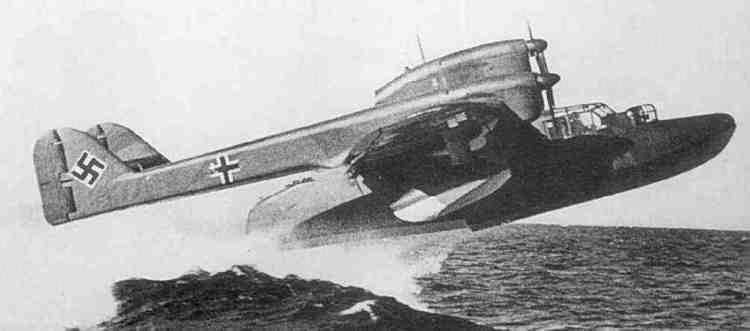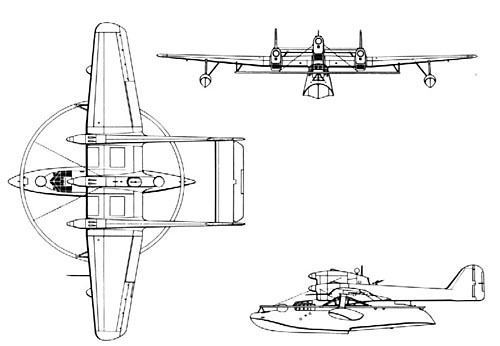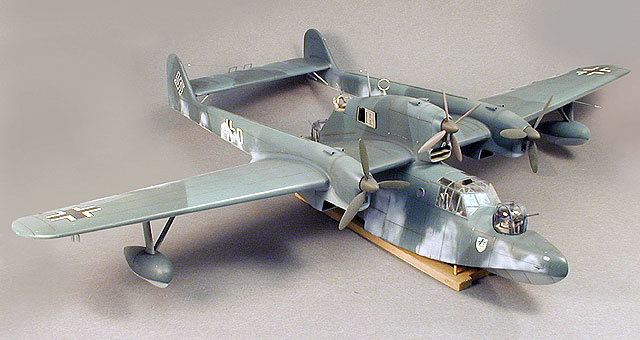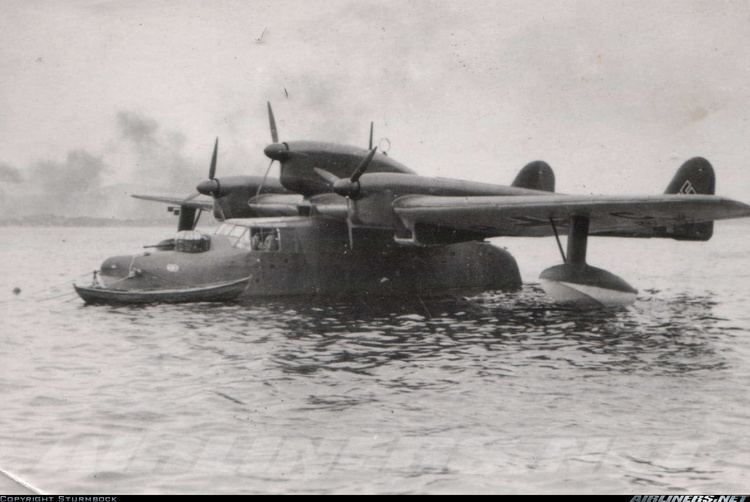Top speed 285 km/h Wingspan 27 m Cruise speed 235 km/h First flight July 15, 1937 | Range 5,000 km Length 20 m | |
 | ||
The Blohm & Voss BV 138 Seedrache (Sea Dragon), but nicknamed Der Fliegende Holzschuh ("flying clog", from the side-view shape of its fuselage) was a World War II German trimotor flying boat that served as the Luftwaffe's main seaborne long-range maritime patrol and naval reconnaissance aircraft.
Contents
- Design and development
- Operational history
- Variants
- Surviving aircraft
- Specifications BV 138 C 1
- References

A total of 297 BV 138s were built between 1938 and 1943.
Design and development

The appearance of the BV 138 was unique, in its combination of unusual design features, such as: twin boom tail unit, trimotor configuration, and fuselage slung beneath the wings. One nickname, "the Flying Clog" was derived from the shape of the slab-sided hull unit. These features together produced the aircraft's ungainly appearance, but inspired a certain affection among its crew and mechanics.

Three piston engines were used. The central engine was mounted above the wing, driving a four-blade propeller, while the wing engines were lower, with three-blade propellers. The pre-production prototypes and the BV 138 A-01 to BV 138 A-06, were powered by various makes of engines ranging from 485–746 kW (650–1,000 hp). The first standardized version, BV 138 B-1, was powered by three 880 PS (868 hp, 647 kW) Junkers Jumo 205D two-stroke, opposed-piston aircraft diesel engines. The engine cowlings also had an atypical appearance, due to the unique nature of the vertical orientation of the six-cylinder opposed-piston Jumo 205 diesel engines, and resembled the cowlings of 4 or 6-cylinder inverted inline engines found on smaller civil and utility aircraft from the Jumo 205's propshaft placement, emerging forward at the uppermost front end of the powerplant.

The booms of the twin tail unit, much like the smaller Focke-Wulf Fw 189 twin-engined reconnaissance monoplane, extended horizontally from the rear of the outer engine nacelles.
For hydrodynamic reasons, the hull featured a distinct "turn-down", or "beak" at the stern.

Two enclosed, powered gun turrets, each mounting a single MG 151/20 autocannon, were located prominently at the bow and stern. A third, fully open Scarff ring-like emplacement, behind the central engine and forward of the rear turret, mounted a 13 mm MG 131 heavy machine gun covered fields of fire obstructed from the other turrets by the horizontal stabilizer.
Operational history

In all, 227 examples of standard service variants of the BV 138 were built. The first such variant, BV 138 C-1, began service in March 1941. While non-standard variants carried a variety of armament, the standard variant featured two 20 mm MG 151/20 cannons, one in a power-operated bow turret and one in a power-operated stern turret, up to three 7.92 mm MG 15 machine guns, and a 13 mm (.51 in) MG 131 machine gun in the aft center engine nacelle. It could carry up to 500 kg (1,100 lb) of bombs or depth charges (under the starboard wing root only) or, in place of these, up to 10 passengers.
Both the B-1/U1 and C-1/U1 variants had racks under both wings to double the offensive load.
Some examples of the BV 138 were adapted to specialized roles. The Bv 138 was tested with the oft-used Walter HWK 109-500 Starthilfe RATO jettisonable rocket pod, used in pairs, for shorter takeoff performance. One anti-shipping variant carried FuG 200 Hohentwiel low-UHF band maritime search radar. The BV 138 MS variant was converted for minesweeping, and carried magnetic field-generating degaussing equipment, including a hoop antenna with a diameter equal to the length of the fuselage, which encircled the hull and wings, which was also used on certain models of the Ju 52/3m trimotor transport used for the same duty.
Variants
Surviving aircraft
No complete BV 138s remain in existence. However, the wreck of one aircraft, sunk after the war in a British air show, was raised from the seabed of the Øresund Sound in 2000, and is on display at the Danish Technical Museum in Helsingør.
On 27 June 2012, two divers (Pascale Roibu and Iulian Rusu) found a Heinkel He 114 seaplane in Siutghiol Lake near Mamaia, Constanta, Romania. During that time, the two divers also found pieces of a Blohm & Voss BV 138 seaplane.
In June 2013, a vessel from the Norwegian Geological Survey filmed a Blohm & Voss BV 138 at a depth of 35 m in Porsangerfjorden, Norway, not far from the WW2 German seaplane harbour in Indre Billefjord.
Specifications (BV 138 C-1)
Data from Wagner, Ray and Nowarra, Heinz. German Combat Planes: A Comprehensive Survey and History of the Development of German Military Aircraft from 1914 to 1945. New York: Doubleday, 1971, pg. 358
General characteristics
Performance
Armament
